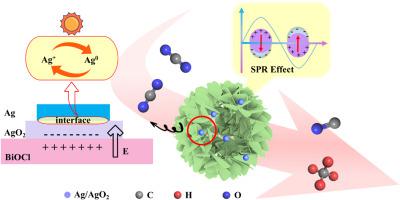Materials Today Physics ( IF 10.0 ) Pub Date : 2023-08-01 , DOI: 10.1016/j.mtphys.2023.101189 Siwen Gong , Fei Rao , Jing Xu , Lujun Zhu , Qadeer-Ul Hassan , Xianjin Shi , Yu Huang , Yanmin Jia , Peizhi Yang , Gangqiang Zhu

|
A series of Ag/Ag2O/BiOCl photocatalysts were prepared by chemically reducing Ag/Ag2O, and loaded it onto BiOCl with the creation of oxygen vacancies. The composite photocatalysts have greatly improved the CO2 photoreduction efficiency. Among them, the yields of 4% Ag/Ag2O loaded BiOCl for CO and CH4 could reach 30.7 μmol∙g−1∙h−1 and 16.0 μmol∙g−1∙h−1 (under simulated sunlight irradiation), 10.8 μmol∙g−1∙h−1 and 1.8 μmol∙g−1∙h−1 (under visible light irradiation), respectively. These yields are 4.7 and 5.3 times, 6.9 and 5.4 times higher than that of pure BiOCl (CO: 6.6 μmol∙g−1∙h−1, CH4: 3.0 μmol∙g−1∙h−1 under simulated sunlight irradiation, CO: 1.6 μmol∙g−1∙h−1, CH4: 0.3 μmol∙g−1∙h−1 under visible light irradiation, respectively). Ag0 exhibits the surface plasmon resonance (SPR) effect, thereby enabling efficient absorption of visible light and subsequent generation of high-energy hot electrons. Ag0 not only enhances the visible light response of photocatalysts, but the generated hot electrons by Ag0 can also actively participate in CO2 reduction reactions. In addition, the formation of Ag2O/BiOCl p-n heterojunction can promote the separation of photogenerated carriers while maintaining the overall redox ability of the semiconductor, leading to a significant improvement in photocatalyst efficiency. Furthermore, the Ag/Ag2O structure is exceptionally self-stable due to mutual electron transport, thereby improving the overall photocatalytic stability of the samples. Density functional theory (DFT) calculations elucidate the formation of the system's ohmic contact and p-n heterojunction. This study provides valuable insights into the significant potential of Ag/Ag2O/BiOCl composite photocatalysts for CO2 photocatalytic reduction.
中文翻译:

具有增强光催化 CO2 还原作用的自稳定等离子体 Ag/p-Ag2O/n-BiOCl 异质结
通过化学还原Ag/Ag 2 O制备了一系列Ag/Ag 2 O/BiOCl光催化剂,并将其负载到BiOCl上并产生氧空位。复合光催化剂大大提高了CO 2光还原效率。其中,负载4% Ag/Ag 2 O的BiOCl对CO和CH 4的产率可达30.7 μmol∙g −1 ∙h −1和16.0 μmol∙g −1 ∙h −1 (在模拟太阳光照射下), 10.8 μmol∙g −1 ∙h −1和 1.8 μmol∙g −1 ∙h −1(在可见光照射下)分别。这些产率分别是纯 BiOCl 的 4.7 和 5.3 倍、6.9 和 5.4 倍(在模拟太阳光照射下,CO: 6.6 μmol∙g −1 ∙h −1 , CH 4 : 3.0 μmol∙g −1 ∙h −1 , CO: 1.6 μmol∙g -1 ∙h -1 , CH 4 : 0.3 μmol∙g -1 ∙h -1 (可见光照射下)。Ag 0表现出表面等离子体共振(SPR)效应,从而能够有效吸收可见光并随后产生高能热电子。银0不仅增强了光催化剂的可见光响应,Ag 0产生的热电子也能积极参与CO 2还原反应。此外,Ag 2 O/BiOCl pn异质结的形成可以促进光生载流子的分离,同时保持半导体的整体氧化还原能力,从而显着提高光催化剂效率。此外,Ag/Ag 2O结构由于相互电子传输而具有异常的自稳定性,从而提高了样品的整体光催化稳定性。密度泛函理论 (DFT) 计算阐明了系统欧姆接触和 pn 异质结的形成。这项研究为Ag/Ag 2 O/BiOCl复合光催化剂在CO 2光催化还原方面的巨大潜力提供了有价值的见解。

































 京公网安备 11010802027423号
京公网安备 11010802027423号